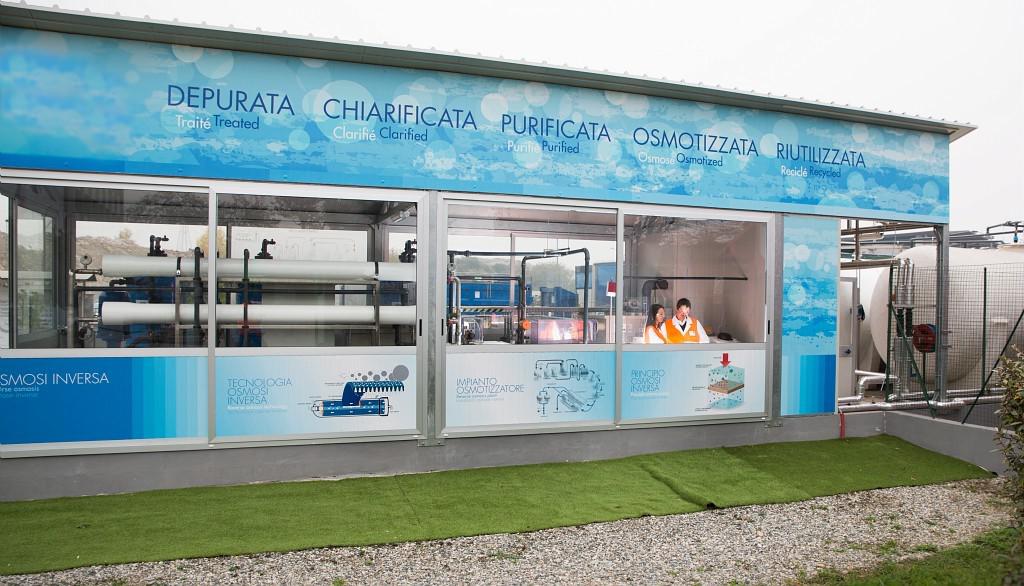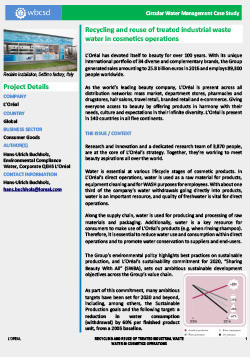L’Oréal has devoted itself to beauty for over 100 years. With its unique international portfolio of 34 diverse and complementary brands, the Group generated sales amounting to 25.8 billion euros in 2016 and employs 89,300 people worldwide.
As the world’s leading beauty company, L’Oréal is present across all distribution networks: mass market, department stores, pharmacies and drugstores, hair salons, travel retail, branded retail and e-commerce. Giving everyone access to beauty by offering products in harmony with their needs, culture and expectations in their infinite diversity. L’Oréal is present in 140 countries in all five continents.
The issue / context
Research and Innovation and a dedicated research team of 3,870 people, are at the core of L’Oréal’s strategy. Together, they’re working to meet beauty aspirations all over the world.
Water is essential at various lifecycle stages of cosmetic products. In L’Oréal’s direct operations, water is used as a raw material for products, equipment cleaning and for WASH purposes for employees. With about one third of the company’s water withdrawals going directly into products, water is an important resource, and quality of freshwater is vital for direct operations.
Along the supply chain, water is used for producing and processing of raw materials and packaging. Additionally, water is a key resource for consumers to make use of L’Oréal’s products (e.g. when rinsing shampoo). Therefore, it is essential to reduce water use and consumption within direct operations and to promote water conservation to suppliers and end-users.
The Group’s environmental policy highlights best practices on sustainable production, and L’Oréal’s sustainability commitment for 2020, “Sharing Beauty With All” (SWBA), sets out ambitious sustainable development objectives across the Group’s value chain.
As part of this commitment, many ambitious targets have been set for 2020 and beyond, including, among others, the Sustainable Production goals and the following target: a reduction in water consumption (withdrawal) by 60% per finished product unit, from a 2005 baseline.
Some of L’Oréal’s manufacturing sites are in regions where water becomes scarce so it is essential to secure water supply and ensure production capacity and sustainable growth.
Objective and project overview
As part of its industrial program, L’Oréal systematically applies simple principles aimed at preserving water resources.
The company’s water management strategy is based on the following main principles:
- Mapping of consumption
- Reducing water consumption by optimizing processes;
- Reusing industrial water before treatment and for a different purpose;
- Recycling wastewater after additional treatment at various stages of the production process (e.g. washing, cooling).
Mapping of water consumption
The “Water scan tool,” a standard tool for analysis and exhaustive mapping of water consumption, is now deployed in all Group plants. This tool helps categorize the different uses of water (washing, cooling, sanitation, etc.) and identify consumption for each of these. The best performances are established as a Group standard, and are then set as a target for each plant.
Reducing water consumption in industrial processes
L’Oréal has worked more particularly on reducing consumption of water for cleaning production equipment and packaging lines. These operations are necessary for maintaining strict hygiene standards and represent 35% of total water use by the industrial sites. The quantity of water used for these operations is reduced to a minimum without affecting product quality and equipment improvements have made it easier to wash the facilities. Through that process, also referred to as the OPTimization Cleaning in Place (OPTICIP) process, training courses in best cleaning practices are provided to operational teams all over the world.
Reuse of industrial water before treatment
Industrial water reuse is encouraged as much as possible. For example, unpolluted cooling water can be reused for cleaning processes of the production equipment.
Promoting recycling and on-site treatment of water that cannot be avoided or reused
Recycling consists in re-treating wastewater when it leaves the site’s wastewater treatment plant using various technologies (ultra-filtration, reverse osmosis, etc.). These operations comply with the Group’s quality standards for reuse in certain industrial processes to clean or cool production equipment.
The business case
At L’Oréal’s manufacturing sites, recycled water is used for cleaning cosmetics production equipment. Depending on the site, up to 50% of the treated wastewater is linked back to the utilities. All incoming and used water is treated on site prior to being used for other purposes. Over 50% of L’Oréal’s factories have on-site wastewater treatment plants, which are essential for recycling. Recycling helps the company limit its environmental impact and enhances sustainable production by reducing freshwater withdrawals and the amount of discharged wastewater while increasing efficiency.
Moreover, as manufacturing sites are located in water-scarce regions or countries such as Egypt or Mexico, reducing water consumption helps reduce dependency on local fresh water resources and anticipate regulatory restrictions.
Considering that about 30% (on average) of the water withdrawal of a manufacturing site goes into the finished product, the target of 60% water withdrawal reduction per finished product unit corresponds to up to 75% reduction (on average) in water used for utilities. This target can only be achieved through recycling of treated wastewater.
Reducing water consumption and recycling treated water requires the optimization of all water consumption processes (e.g. cooling systems, cleaning processes, boilers, vacuum pumps etc.). For example, optimization of the cleaning process drastically reduces demand for chemicals and energy during wastewater treatment, leading to potential significant cost savings. Thus, there are multiple opportunities to lower environmental impact and reduce operational costs.
Decision making process
The targets of the SBWA program are set by the top management and are cascaded down to all management levels.
More specifically, the act of recycling treated water and reusing it in the utilities is managed by the following departments:
- the local EHS teams are responsible for the treatment of water,
- the quality department oversees the water quality for reuse and is responsible for the production unit
The local EHS teams and the quality department must convene to align their respective decisions on the process.
Project details & finances
In 2016, ten cosmetic production sites had been equipped with water recycling systems in Karlsruhe, Germany; Rambouillet, France; Aulnay, France; Libramont, Belgium; Burgos, Spain; Settimo, Italy; Istanbul, Turkey; Pune, India; Suzhou, China; and Montreal, Canada. These sites can cover up to 50% of their utility water needs in treating and recycling the industrial effluents.
Example at Settimo site
The plant is operating a biological wastewater treatment plant onsite to pre-treat the industrial effluents before discharge to the public sewer. Since 2014, the plant in Settimo, Italy, has been treating its wastewater by evapoconcentration. This technology involves heating the effluents to recover the treated water, which can then be recycled. This process also enables recovery of the concentrates. The factory therefore, installed the necessary amenities to reuse a heat source already available onsite – the compressors. As a result, evapoconcentration does not consume any additional energy - but waste generation, another technical aspect inherent to evapoconcentration technology, had to be addressed.
Evapoconcentration produces concentrates that need to be eliminated, like the sludge from the wastewater treatment plant. To ensure that the overall calculation is positive, a portion of the liquid waste to be destroyed (manufacturing losses, non-compliant waste fluids, etc.) is also treated with the evapoconcentrator to recover the water. This reduces the factory’s overall waste generation. By decreasing the load of effluents to be treated, the system also helps improve the efficiency of the site’s water purification plant.
The teams who developed this project have focused on optimizing the entire process so that the environmental equation – dependent upon the water treatment efficiency, liquid wastes, availability of the energy needed, etc. – and the economic equation – based on costs of energy, water, waste treatment, etc. – are positive.
Since 2016, additional equipment such as ultrafiltration and reverse osmosis were installed to treat the final effluents of the biological wastewater treatment plant.
Considering all the water optimization projects that are underway, the site’s water-consumption has decreased by more than 50% compared to 2013.
Project results
Reducing water consumption generates multiple benefits. Some are linked to the “value” of water whereas others are linked to the “cost” of water.
When it comes to the latter – i.e. the financial benefits of water saving –, it is important to consider the additional benefits: lower energy consumption for water heating, no softening needed for recycled water because it is already treated by reverse osmoses, fewer demand for chemicals etc.
The recycling rates of treated water are different from one site to another but on average, in 2016, the sites with recycling plants could cover about 36% of their water demand for utilities with recycled water.
Financial data about return on investment or financial savings are not yet available because this global project needs monitoring for a long period of time.
Lessons learned
One of the key lessons is that the water consumption processes had to be optimized in parallel to the reduction of the waterflow. It was important to reduce the material loss to wastewater, to not increase the pollution concentrations. In reducing these losses, significant financial savings are possible. In addition, the reduction of bulk losses to drain improves the production efficiency and avoid waste and wastewater treatment cost.
Key success factors include:
- Participation of all internal stakeholders and collaborators
- Communication about the overall benefits of water, its value and cost
- Linking water savings with improved process efficiency
- Openness for technical innovation and breakthrough applications of new technologies
Future implementation and next steps
The company will roll out recycling projects on manufacturing sites. In the long-term, the use of freshwater on industrial sites will be reserved for specific use (e.g. domestic use) and only if required to guarantee the quality of the finished product.
In addition to these projects, L’Oréal strives to share best practice from the cosmetics industry for a circular water management approach and to learn from other industries.
For example, knowledge is shared through participation in WBCSD’s Water Cluster and work on water reuse, recycling and resource recovery.
Download case study
References
- Video on the Settimo site project: https://www.youtube.com/watch?v=Zcfp0L0EWeM
This case study forms part of the WBCSD Business Guide to Circular Water Management (2017), available for download here.
Project detailsCompany: L’Oréal Country: Global Business sector: Consumer Goods Author(s): Hans-Ulrich Buchholz, Environmental Compliance Water, Corporate QEHS L’Oréal Contact information: Hans-Ulrich Buchholz, hans.buchholz@loreal.com |



